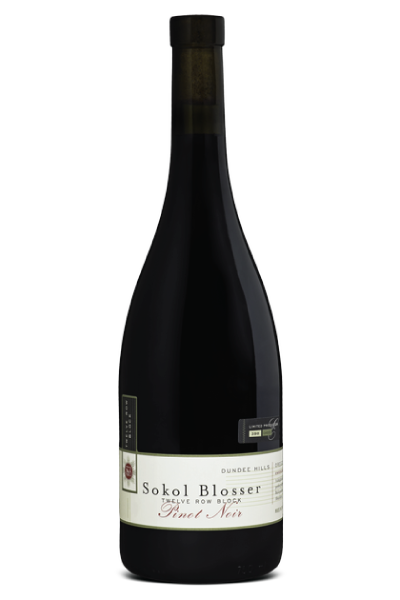
The Vineyard
Only 12 rows of approximately 60 vines per row comprise this prized Pinot Noir block. The one acre of Pommard clone was planted in 1975 at 6’ x 10’ spacing on own-rooted plants. Elevation is about 300’; slope is east; soil is Jory clay loam. This block is part of the parcel the Blossers purchased from their neighbors, Ted and Verni Wirfs, local farmers who told Bill and Susan that this parcel was the “banana belt” of the area because their fruit always ripened earlier than that of neighboring farms. Sokol Blosser has found that to be true.
The Vintage
2003 was not a typical (meaning “what we’ve come to expect in Oregon”) vintage. We had an extremely cool and wet March, April and May, followed by a very hot, dry summer, during which there were many days in the upper 90’s or even over 100 degrees. After the record heat in June, July and August we finally had rain on September 7th, just as we were poised to begin harvesting. It rained for four days (quite heavily at times), and we had a record low high temperature on September 9th. During the next eight days the weather stayed cool in the mornings, warm in the afternoons, and we were able to harvest small amounts of our early ripening young Pinot Noirs. Then, on September 20th, the weather became noticeably warmer in the afternoons, and by the 21st the hot east winds had really kicked in. At that point it became a race to harvest the grapes before they became dehydrated and shriveled or the sugar content went too high. By the 27th the unrelenting winds had pushed the temperatures to record highs – it was 70o at 7 am that day and 98o in the afternoon, the highest temperature ever recorded that late in the year. Between the 20th and the 29th, when it finally cooled, we pulled in about 85% of our total harvest. The weather was truly the big story of the 2003 vintage.
The Winemaking
The grapes were de-stemmed directly into one small (three-ton) open-top fermenter, preserving as many whole berries as possible. They were given two days of pre-fermentation maceration, then manually punched-down gently three times per day during a ten day fermentation. Finally, the wines were given a very long (twenty-three day) post-fermentation maceration.
The long post-fermentation maceration is an extremely important component of our winemaking. As the newly fermented wine rests in contact with the skins it extracts color, complexity and tannins. The tannins initially are “short-chain” molecules: hard, green, bitter and aggressive – not what any winemaker wants. The wine tends to get more and more harsh and bitter for the first two to three weeks. If we were to remove the wine from the skins at that point we would be creating a wine with very coarse, harsh tannins which could take many years to (or may never) soften, or require heavy fining. However, if the wine is left for about three weeks, at a certain point the short-chain tannins polymerize (chemically bond) to form long-chain tannins, which are soft, supple and silky. Every fermenter is slightly different. In some the change occurs at nineteen days. In others it may take twenty four days. But in each case it is done by taste and when the transformation has taken place it is time to press. Now the wine has gained tremendous complexity, more stable color, and a beautiful soft, silky texture that makes it accessible (and pleasurable) when young, yet it still has the tannin structure for long-term ageability.
After pressing, the wine went very quickly to barrels where it underwent a very long, slow malolactic fermentation. The barrels, 63% of which were new, were all fine-grain French oak from a number of different Burgundian cooperages.
The Blend
Small amounts of wine from five different barrels were blended to create the final blend of only about 100 cases.
The Wine
Extraordinary richness, power, intensity, depth and concentration characterize the wine from this block. There is licorice, cassis and a wonderful earthy, loamy character. The tannins are smooth and polished, the texture silky and the finish is long and luscious. While the Twelve Row Block wine is usually very fleshy and rich, the high sugar in the grapes in 2003 (and consequent higher alcohol in the wine) has made the wine even more opulent, lush, deep and powerful.